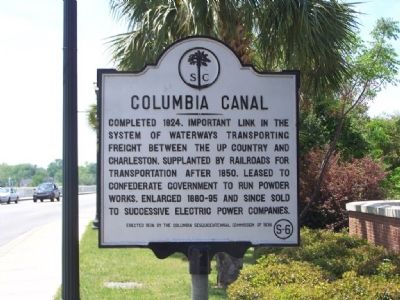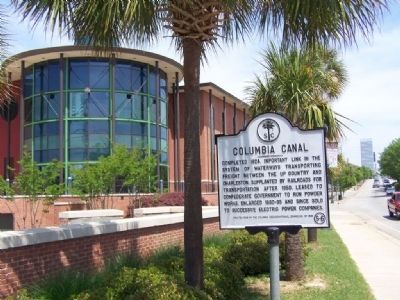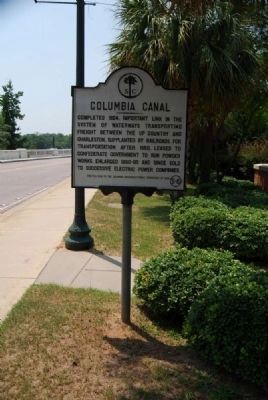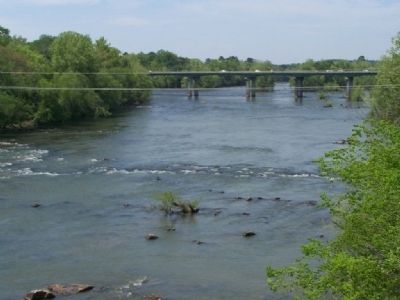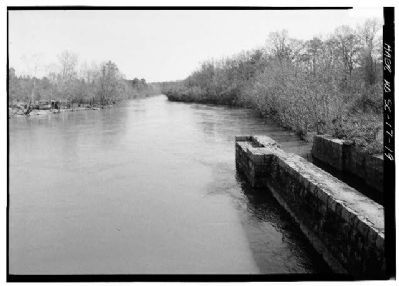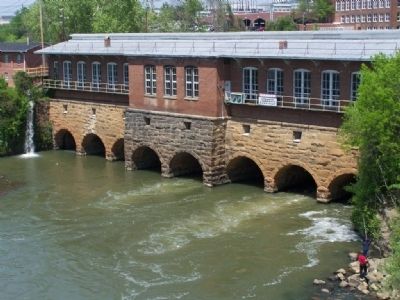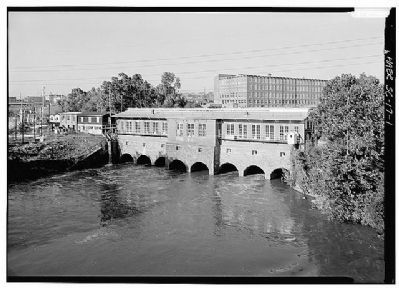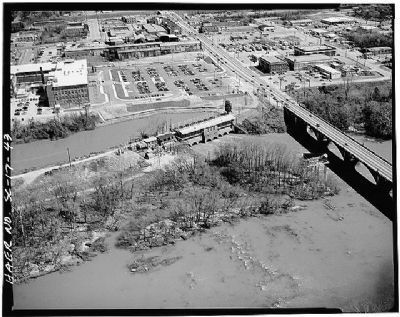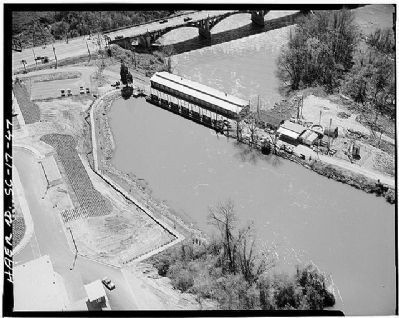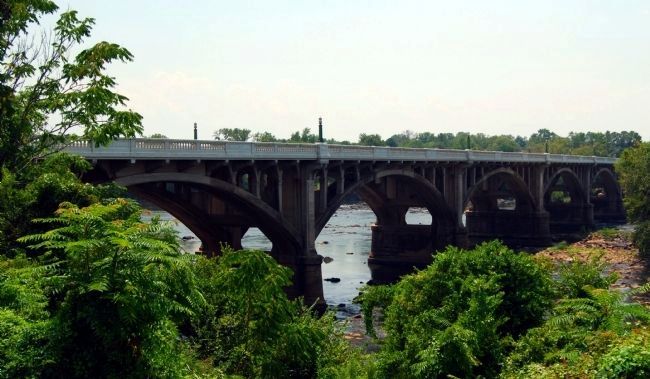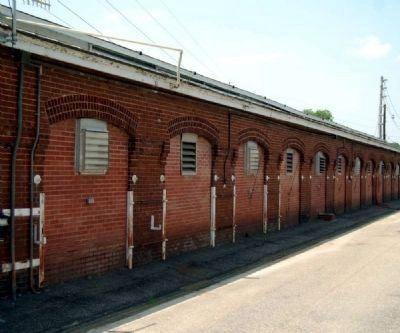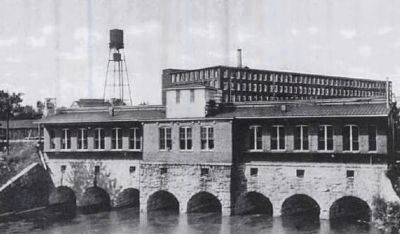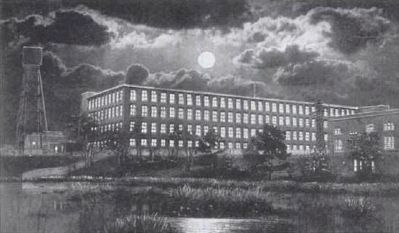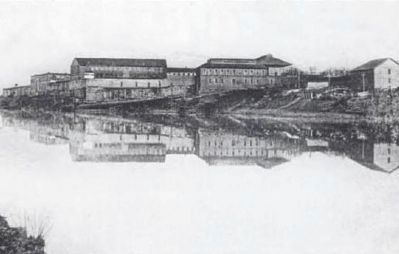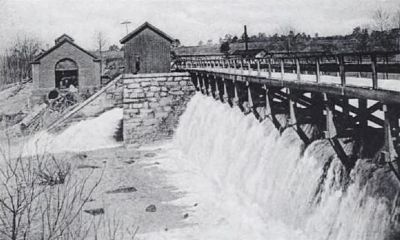Midtown - Downtown in Columbia in Richland County, South Carolina — The American South (South Atlantic)
Columbia Canal
Completed 1824. Important link in the system of waterways transporting freight between the up country and Charleston. Supplanted by railroads for transportation after 1850. Leased to Confederate Government to run powder works. Enlarged 1880-95 and since sold to successive electric power companies.
Erected 1938 by The Columbia Sesquicentennial Commission of 1936. (Marker Number S-6/40-37.)
Topics. This historical marker is listed in these topic lists: Industry & Commerce • Notable Places • Waterways & Vessels. A significant historical year for this entry is 1824.
Location. 33° 59.794′ N, 81° 2.913′ W. Marker is in Columbia, South Carolina, in Richland County. It is in Midtown - Downtown. Marker is on Gervais Street (U.S. 1) near Gist Street, on the left when traveling east. Touch for map. Marker is in this post office area: Columbia SC 29201, United States of America. Touch for directions.
Other nearby markers. At least 10 other markers are within walking distance of this marker. Gervais Street Bridge (within shouting distance of this marker); Congaree River Bridges (within shouting distance of this marker); Harnessing Water Power (within shouting distance of this marker); 1896 Power Plant (within shouting distance of this marker); Doolittle Raiders (about 500 feet away, measured in a direct line); Williams Street / Gist Street (about 500 feet away); Huger Street (approx. 0.2 miles away); Milestones (approx. ¼ mile away); Friday’s Ferry (approx. ¼ mile away); Old Congaree River Bridges (approx. ¼ mile away). Touch for a list and map of all markers in Columbia.
Regarding Columbia Canal. National Register of Historic Places:
Columbia Canal *** (added 1979 - - #79002392)
♦ E bank of the Broad and Congaree Rivers from the Diversion dam to the Southern RR Bridge , Columbia
♦ Historic Significance: Information Potential, Event, Architecture/Engineering
♦Architect, builder, or engineer: Holley,Byron
♦Architectural Style: Other
♦Area of Significance: Historic - Non-Aboriginal, Transportation, Industry, Invention, Commerce, Engineering
♦Cultural Affiliation: Nineteenth Century American
♦Period of Significance: 1875-1899, 1825-1849
♦Owner: State , Private , Local
♦Historic Function: Industry/Processing/Extraction, Transportation
♦Historic Sub-function: Manufacturing Facility, Water-Related
♦Current Function: Industry/Processing/Extraction, Landscape
♦Current Sub-function: Energy Facility, Park
Also see . . .
1. Columbia Canal. The Columbia Canal is the surviving canal of a series of canals built by the State of South Carolina in 1824 using the labor of Irish immigrants to provide a direct water routes between the upstate settlements and the towns on the fall line. (Submitted on August 14, 2009, by Brian Scott of Anderson, South Carolina.)
2. SC Nature: Columbia Canal - 7.26.08. The sights and sounds from the Riverwalk at Columbia Canal, downtown Columbia, SC. (Submitted on July 25, 2011, by Brian Scott of Anderson, South Carolina.)
3. Columbia Canal. The Columbia Canal has played an important role in the commercial and industrial development of Columbia. (Submitted on August 14, 2009, by Brian Scott of Anderson, South Carolina.)
4. Columbia Canal and Riverfront Park. Featuring plenty of river views, the Riverfront Park is a nice place to unwind and get away, being within walking distance of Columbia′s business district. (Submitted on July 25, 2011, by Brian Scott of Anderson, South Carolina.)
Additional commentary.
1. Columbia Canal - National Register Nomination Form (1978)
Description
The Columbia Canal, located directly adjacent to Columbia, South Carolina, was constructed between 1820 and 1824 as a means to navigate around the rapids of the Broad River where it joins the Saluda River to form the Congaree River. In 1891 the northern section of the Canal was enlarged to extend further down the Broad River in order to serve as a power source for the industrial development of Columbia.
The area of the Columbia Canal nominated to the National Register includes the remains of the 1824 Canal and the complete area of the 1891 Canal which is still intact and in use as an important source of power for the city of Columbia. The nominated area commences at the Southern Railroad Bridge and extends north along the banks of the Congaree River and inland to include the remains of the 1824 Canal. It then runs along the entire length of the 1891 Canal and levee. This 1891 section commences at Gervais Street and runs approximately 2.6 miles to its termination point at the canal bulkhead and diversion dam. The nominated area also encompasses a portion of the Broad and Congaree Rivers, including the rapids which were so instrumental in the decision to construct a canal adjacent to Columbia.
The 1824 Columbia Canal was designed to take advantage of a natural ravine which lay between the city and the Broad and Congaree Rivers. The canal was approximately 3 1/8 miles long and overcame a river fall of 34 feet. The 1824 Canal originated between Lumber and Richland Streets and terminated opposite the Granby landing. The canal had five turning basins with the principle basin located at the end of Senate Street. North of this basin the canal was 12 feet wide with 2 1/2 feet of water; south of the basin it was 18 feet wide with 4 feet of water. The banks of the canal were earthen, planted with grass, with an 8-foot wide tow path running on either side of the canal. The 1824 Canal had 4 lifting locks and 1 guard lock constructed of brick and granite. In order to allow water to bypass the canal and prevent flooding. the canal had 3 waste weirs and 6 culverts. This canal system also included a diversion dam, completed in 1824, which extended across the Broad River to allow easy access from the nearby Saluda Canal to the Columbia Canal.
With the coming of the railroad, the 1824 Canal was gradually abandoned as a means of transportation. It was allowed to deteriorate and eventually a part of it was incorporated into the 1891 Canal. Nevertheless, substantial evidences of the old canal remain in the area extending from Gervais Street to the Southern Railroad Bridge. In the area south of Gervais Street to Green Street the original 1824 canal bed can be seen in a deteriorated state. From Green Street south to Wheat Street, no traces of the canal are
clearly visible. South of Wheat Street to approximately 100 yards north of the Southern Railroad Bridge, the 1824 canal bed remains intact~ Major remains in the old canal area include an original waste weir, a major culvert, several small culverts, the remains of the Old River Front Bridge, the remains of an early water pumping station, and approximately 1 1/2 miles of the 1824 canal bed with tow paths. Further archaeological investigation should reveal additional evidences of the 1824 Canal.
The majority of the area of the 1824 Canal is currently open space and woodlands. A portion of the area extending from Gervais Street to Blossom Street is currently being developed by the City of Columbia as a Bicentennial Park.
In 1888 the Board of Trustees for the Columbia Canal embarked on a program designed to make the Columbia Canal an important power source for the industrial development of the city. This program involved the enlargement of the original canal from Gervais Street to Lumber Street and the addition of 2 7/8 miles to the north end of the canal extending up the Broad River. The enlarged canal was opened on November 21, 1891. It ran approximately 3 1/2 miles and was 150 feet wide at surface and 10 feet deep. Its notable engineering features included a massive diversion dam, entry lock, bulkhead, and waste weir. The completion of the canal led to the rapid development of its levee as a site for power generation facilities.
The Columbia Canal of 1891 remains virtually intact and is still in use as one of the primary sources of power for the city of Columbia. In addition, the canal levee features both ruins and extant structures which date from the period of the canal's initial development as a power source.
The notable features of the Columbia Canal as it extends north from Gervais Street includes the following:
Columbia Hydro Plant: Built in 1896 by the Columbia Water Power Company, this plant was designed to supplement the Columbia Mills Power House located directly to the north. The Columbia Hydro Plant furnished electricity for all the lights in the city, public and private current for manufacturing, and for the operation of the Street Railway System. The plant is still in use and is a major power source for the city of Columbia. It is the oldest functioning plant of the South Carolina Electric and Gas Company's power system.
This brick structure is set on a random ashlar stone base with arches. Symmetrical in design, it features repetitive paired windows spanned by jack arches, wide eaves supported by simple wood brackets and brick corbels along the roof line.
Columbia Mills Power House Ruins: Completed in 1894 by the Columbia Water Power Company, this plant was
built to supply the needs of the Columbia Duck Mill located directly across the canal some 600 feet away from the Power House. This Power House was considered to be the first in the nation to utilize hydroelectric power to drive a large textile mill.
The bulk of this brick structure was demolished approximately 16 years ago. However, visible traces of the plant remain. Notably the massive flumes which extended underneath the canal, the water gates. and the bridge abutments for the iron bridge that linked the Power House to the mill.
Columbia Electric Street Railway, Light & Power Company Power House Ruins: Evidence indicates a mill on this site as early as 1872. This power house was definitely located on the site by 1893, and was probably constructed by the State Penitentiary prior to 1892 when it was sold to C.E.S.R.L.&P. Co.
The massive ruins of the plant consist of the arched foundation walls and interior archways which were constructed of granite. brick and stone.
Waste Weir: Completed in 1891 as part of the enlarged canal. this waste weir is 200 feet long with 6 waste gates. It is of heavy masonry construction and is surmounted by a wooden bridge. Designed to control the water level of the canal. this weir remains intact and functioning.
Old Water Works Complex: Located directly adjacent to the waste weir
is a small complex which served as an early city waterworks system. Evidence indicates that this site was used as a waterworks as early as 1895. Remaining on the site are three intact structures and the foundations of a fourth structure; The intact structures are 1) a Water Pumping Station built prior to 1905 of brick construction featuring outward projecting semicircular arches over doors and windows; 2) a concrete structure featuring a massive water-tight entrance door surmounted by an arched window; 3) a simple outbuilding with metal siding. At the present time, this complex is not being used.
Site of the Original Diversion Dam: Completed in 1824, this Diversion Dam extended across Broad River and was designed to provide access from the nearby Saluda Canal to the Columbia Canal a thus making the waterway a useful form of transportation beyond the immediate environs of Columbia. This diversion dam was 1,500 feet long and rose 6 feet above the surface of the water.
Although no visible traces or this dam remain, a heavy concentration of stone and rubble makes this site a potential area for archeological investigation.
Bull Sluice: Located at the northern end of the 1891 Canal, Bull Sluice was not part of the original Columbia Canal. Instead it was a separate lock designed to navigate around a small set of rapids in the Broad River. completed
in the early 1820s, Bull Sluice was approximately 1/2 mile in length. The Sluice had 1 granite lock which overcame a fall of 8 feet. In 1891, the Columbia Canal was extended northward beyond the area of Bull Sluice, thus making the Sluice a secondary section of the river. At the present time, much of Bull Sluice remains intact.
Canal Bulkhead: Completed in 1891, the bulkhead, with its 12 massive archways, is the means by which water is introduced into the canal. It consists of abutments, piers, arches, and parapet walls of granite masonry laid up in hydraulic cement. The flow of the water is controlled by 24 gates. Although an original tin shed covering the bulkhead machinery is gone, the bulkhead itself and its machinery remain intact.
Canal Entry Lock: Completed in 1891, this lift lock provided the only means of entering t e canal from the Broad River. Constructed of granite masonry laid in hydraulic cement mortar, the lock 1s 16 feet wide and 95 feet long. It is located at the west end of the bulkhead and its west wall is connected to-the diversion dam by a guard wall of masonry. The entry lock remains relatively intact and functioning.
Diversion Dam: Constructed in 1891, the purpose of this dam was to form a pond in the Broad River from which water could be drawn into the canal. The dam was 1000 feet long as measured at its crest
and was constructed of pine cribs and granite. In 1928 a concrete apron was laid on top of the rock crib dam in order to improve its efficiency. Since that time the dam has remained intact and functioning.
The Columbia Canal is traversed by several major highway bridges, notably the Gervais Street Bridge, the Hampton-Meeting Street Expressway, the I-26 Bridge, and the Sunset Drive Bridge. None of these structures significantly affects the canal. In addition, included in the nominated area and directly adjacent to the old Water Works Complex, is a circa 1905 steel truss bridge which leads across the canal to the present waterworks.
The Columbia Canal is a primary power source for the City of Columbia and is consequently a working industrial facility owned and operated by South Carolina Electric & Gas Company, a public utility, under a license issued by the Federal Energy Regulatory Commission (FERC). The canal's lands are presently being used as a major transmission line corridor. At present there are six generators with a generating power of 14,000 kilowatts located on the canal levee. Although there are no present plans to change the power capability of the canal, future energy needs may well necessitate the addition of supplementary towers and poles in the canal area. In addition, as a public utility, the South Carolina Electric & Gas Company is interested in the possible development of newer, more efficient, and better generating facilities for the generation and transmission of power. Because this is a working facility, possible future changes to the existing canal are foreseen.
The City of Columbia Water Works is located adjacent to, but not within, the nominated area. The intake for the Works is in the canal and the pump house is on the bank. There are currently plans to locate another water pump in the canal (within the nominated area) in order to supplant the one already in use by the City Waterworks. The city anticipates that there may be additional installations for the Waterworks from time to time.
The existing transmission towers and poles are not to be considered as an intrusion since they are an integral part of this engineering/industrial area. As the existing 1891 Columbia Canal was constructed totally for power generation and was never intended to be used as a means for transportation, transmission towers and Doles located on the canal levee are in keeping with the engineering evolution of the power generation facilities located on the Columbia Canal. South Carolina Electric & Gas Company plans to build additional transmission lines in the area of the Canal and to rebuild and upgrade existing facilities from time to time.
Surroundings: The Columbia Canal is directly contiguous to
the City of Columbia. Bordering the canal, but not included in the nominated area are several notable structures, including the original Columbia Duck Mill, the Central Correctional Institute, and the City of Columbia waterworks. also bordering the canal, but not in the district, are an industrial facility of U.S. Steel Company, a strip of Southern Railroad track, and a maintenance facility for a local machinery firm. None of these elements alters the historic integrity of the canal area.
The nominated area of the Columbia Canal includes the minimal acreage necessary to protect the historic integrity of the Canal. In 1977 the South Carolina State Historic Preservation Office, in conjunction with the City of Columbia, sponsored a study of the historical, cultural, and recreational resources of the Columbia Canal. The boundaries of the nominated area of Canal closely follow the significant areas delineated by this Columbia Canal Study. The Columbia Canal Study, compiled by Wilbur Smith and Associates, will soon be released 1n published form.
Significance
The Columbia Canal has played an important role in the commercial and industrial development of Columbia, the capitol of South Carolina. Historically significant for its influence on the city's growth, the Columbia Canal is also a notable example of the engineering expertise of-the 19th century.
Completed in 1824, the Columbia Canal was designed to enable the navigation of the Broad and Congaree Rivers at their confluence in Columbia. The canal was part of a state-sponsored system of internal improvements designed to create inexpensive and efficient transportation facilities across South Carolina. The Columbia Canal contributed substantially to the emergence of Columbia as the commercial center of the upper part of the state. Although its importance as a means of transportation significantly decreased after the arrival of the railroad in Columbia in 1842, the canal continued to be used for local commerce and provided water power for small industries. The Columbia Canal was the only canal project in the state which remained;n use after the advent of the railroad and steam-propelled craft. During the Civil War a portion of the Columbia Canal was leased to the Confederate government. After the close of hostilities, the canal passed through several owners before reverting to the state.
In 1888, as part of the post-Civil War movement to industrialize the South, the State of South Carolina decided to enlarge the canal as a means of providing: a power source to aid in the industrial development of Columbia. In 1891 the enlarged Columbia Canal was completed. The canal subsequently served as an impetus to the establishment of mills and factories in Columbia,
thereby playing an important role in the growth of the city. In addition, the Columbia Canal was the site of one of the first power houses in the nation to utilize hydroelectric power to drive a large textile mill. Since its completion in 1891 the Columbia Canal has continuously served as a major power source for the city of Columbia.
Archeology-Historic Significance
The Columbia Canal is likely to yield information important to history as follows:
Canal Construction: Archaeological techniques could be applied to the relatively intact segments still remaining from the 1824 canal in order to obtain more detailed information about the construction of the canal bed, tow paths, culverts, and other engineering features. Such information would be important to comparative studies with other canals of the period (e.g. Landsford Canal, National Register, 1969) and with the later 1891 Columbia Canal.
Canal Use: Excavation in the old 1824 canal bed is likely to produce artifacts that would help interpret the canal's use while it was active. Artifacts might also be found indicating use of the canal bed, such as, perhaps, for trash deposition, after its abandonment.
Use of the 1891 canal is reflected by the various ruined structures that remain along it. Archaeological reconstruction could prove particularly useful to the interpretation
of the following: Columbia Mills Power House Ruins, Columbia Electric Street Railway, Light & Power Company Power House Ruins, Old Water Works Complex {where there is a foundation for a no longer extant structure}, Site of the Original (1824) Diversion Dam, Bull Sluice (especially ~the site of its granite lock). In each of the above cases archeological and documentary information would be mutually supportive.
Engineering Significance
The Columbia Canal reflects the development of 19th century canal engineering techniques from the simple designs of the 1820s to the more sophisticated forms of the 1890s. The remains of the 1824 Columbia Canal are indicative of the type of canal design typical of similar canal systems constructed for navigation in South Carolina during the 1820s. In the late 19th century industrialists began to envision the canal as a potential power source, thereby creating a need for new canal engineering techniques. The 1891 Columbia Canal reflects the advances made in canal engineering in the post Civil War era. Its massive bulkhead, waste weir, and diversion dam were more ambitious in scale and more sophisticated in design than-that of the 1824 canal. It is particularly significant to note that the Columbia Canal of 1891 is intact and is a functioning example of 1890s canal engineering.
Transportation/Commerce Significance
In 1817 the State of South Carolina embarked on a broad program of internal improvements designed to provide an inexpensive and efficient method of transportation through the creation of a system of canals and navigable rivers. Under the auspices of a Board of Public Works and later a Superintendent of Public Works, some 25 miles of canal were completed across the state. As part of this program the Columbia Canal was constructed between 1820 and 1824 to navigate around the rapids of the Broad and Congaree Rivers. The Columbia Canal subsequently played an invaluable role in the development of Columbia into the state's largest cotton shipping point in the interior and a major commercial center for supplies and credit. With the coming of the railroad, canals became obsolete as an efficient form of transportation. With the exception of the Columbia Canal, all the canal projects across the state were Ultimately abandoned. The Columbia Canal remained steadily in use as a transportation facility well past the Civil War, serving cotton boats making local deliveries.
Industry Significance
Although basically designed for navigation, the 1821 Columbia Canal was also the site of several small industries such as grist mills and saw mills. As the canal became obsolete as an efficient means of transportation, the State of South Carolina began to envision the Columbia Canal as a potential power source which would be used to attract outside capital into the state. in 1888 a Board of commissioners of the Columbia canal was established for the purpose of enlarging the canal in order to make it a valuable power source. Expanded under the direction of civil engineer Byron Holley, the enlarged canal was officially opened on November 21, 1891. Subsequently, the canal successfully attached new industry to Columbia by means of its plentiful and inexpensive water power and its ample frontage for mill sites. It thereby played an invaluable role in the industrial development of Columbia, South Carolina.
Invention Significance
In 1894 the Columbia Canal became the site of an important development in the electrification of textile mills. At that time a northern textile manufacturer constructed the Columbia Duck Mills on a site adjacent to the Columbia Canal. (The mill is not included within the nominated property.) A power house for the mill was constructed on the Columbia Canal some 600 feet away from the mill itself. Impatient with the heavy expense of originary mechanical power transmission from waterwheels to mill machinery, the owners of the Columbia Duck Mills decided to drive the mill with power generated and electrically transmitted from the Columbia Canal. Sidney B. Paine of General Electric Company completed the contract for electrification of the mill. The resulting power system was significant for 3 basic reasons. First, it was one of the first power systems in the nation to utilize power transmitted at a distance from the point of generation. This development meant that a mill could now be located away from the water source with its threat of floods. Second, it was a new tyoe of drive motors, commonly utilized in textile power. Finally, it used a new type of drive system which applied power in individual and group motor drive instead of the traditional shaft-belt-pulley system of power transmission.
— Submitted August 14, 2009, by Brian Scott of Anderson, South Carolina.
Credits. This page was last revised on February 16, 2023. It was originally submitted on April 21, 2008, by Mike Stroud of Bluffton, South Carolina. This page has been viewed 2,804 times since then and 57 times this year. Last updated on September 10, 2008, by Mike Stroud of Bluffton, South Carolina. Photos: 1, 2. submitted on April 21, 2008, by Mike Stroud of Bluffton, South Carolina. 3. submitted on August 24, 2011, by Brian Scott of Anderson, South Carolina. 4. submitted on April 21, 2008, by Mike Stroud of Bluffton, South Carolina. 5. submitted on May 29, 2010, by Mike Stroud of Bluffton, South Carolina. 6. submitted on April 21, 2008, by Mike Stroud of Bluffton, South Carolina. 7. submitted on May 8, 2012, by Mike Stroud of Bluffton, South Carolina. 8, 9. submitted on May 29, 2010, by Mike Stroud of Bluffton, South Carolina. 10, 11, 12, 13, 14, 15. submitted on August 14, 2009, by Brian Scott of Anderson, South Carolina. • Kevin W. was the editor who published this page.
